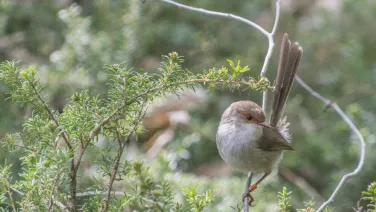
Cockburn Group - Evolutionary ecology
Current work focuses on cooperative breeding of superb fairy-wrens and woodswallows.
Division
About
Cooperative breeding occurs where more than two individuals combine to rear a single brood of young. It is extraordinarily prevalent in the Australian avifauna, for both phylogenetic and ecological reasons, and we are conducting a number of studies to understand this prevalence. Current work focuses on superb fairy-wrens and woodswallows, though we have worked with kookaburras, bee-eaters, kingfishers, thornbills, choughs and parrots.
Awards
- President of the International Society for Behavioral Ecology (from 2018 to 2020), 2018
- Member of the Order of Australia (AM), 2011
- Fellowship (Honorary Life Member) of the Australian Mammal Society, 2010
- Ellis Troughton Memorial Award, 2010
- Peter Baume Award, 2006
- Nils von Hofsten Award, 2006
- DL Serventy Medal, 2004
- Centenary Medal, 2003
- Fellow of the Australian Academy of Science, 2001
- Distinguished Visiting Ecologist, Colorado State University, 1993
- Gottschalk Medal, 1988
- Edgeworth David Medal for Zoology, 1987
- Whitley Award, 1985
Publications
Selected publications
- Cockburn, A 2013, 'Cooperative Breeding in Birds: Toward a Richer Conceptual Framework', in Kim Sterelny, Richard Joyce, Brett Calcott & Ben Fraser (ed.), Cooperation and Its Evolution, MIT Press, London, pp. 223-246.
- Dalziell, A, Peters, R, Cockburn, A et al 2013, 'Dance choreography is coordinated with song repertoire in a complex avian display', Current Biology, vol. 23, no. 12, pp. 1132-1135.
- van de Pol, M, Brouwer, L, Brooker, L et al 2013, 'Problems with using large-scale oceanic climate indices to compare climatic sensitivities across populations and species', Ecography, vol. 36, pp. 249-255.
- Cockburn, A, Brouwer, L, Double, M et al 2013, 'Evolutionary origins and persistence of infidelity in Malurus: the least faithful birds', Emu, vol. 113, pp. 208-217.
- Margraf, N & Cockburn, A 2013, 'Helping behaviour and parental care in fairy-wrens (Malurus)', Emu, vol. 113, pp. 294-301.
- Buchanan, K & Cockburn, A 2013, 'Fairy-wrens and their relatives (Maluridae) as model organisms in evolutionary ecology: the scientific legacy of Ian Rowley and Eleanor Russell', Emu, vol. 113, pp. i-vii.
- Aplin, L & Cockburn, A 2012, 'Ecological selection and sexual dimorphism in the sooty oystercatcher, Haematopus fuliginosus', Austral Ecology, vol. 37, pp. 248-257.
- van de Pol, M, Osmond, H & Cockburn, A 2012, 'Fluctuations in population composition dampen the impact of phenotypic plasticity on trait dynamics in superb fairy-wrens', Journal of Animal Ecology, vol. 81, no. 2, pp. 411-422.
- Remes, V, Matysiokova, B & Cockburn, A 2012, 'Nest predation in New Zealand songbirds: Exotic predators, introduced prey and long-term changes in predation risk', Biological Conservation, vol. 148, pp. 54-60.
- Remes, V, Matysiokova, B & Cockburn, A 2012, 'Long-term and large-scale analyses of nest predation patterns in Australian songbirds and a global comparison of nest predation rates', Journal of Avian Biology, vol. 43, pp. 435-444.





